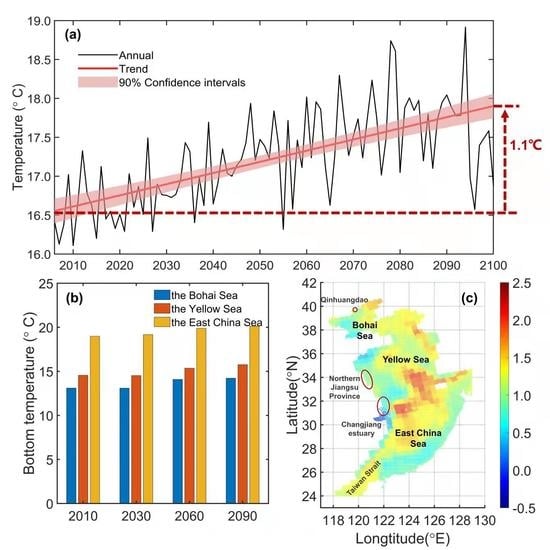Projected Sea Bottom Temperature Variability in the East China Shelf Seas by 2100
Abstract
1. Introduction
2. Data and Method
2.1. Data
2.2. Study Area
2.3. Bottom Temperature Determination
3. Model Validation and Simulation Result Improvement
4. Projection of Interannual and Interdecadal Bottom Temperature Changes in ECSSs
4.1. Projection of Interannual Bottom Temperature Changes in ECSSs
4.2. Projection of Interdecadal Bottom Temperature Changes
4.3. Projection of Interdecadal Seasonal Bottom Temperature Variations
5. Discussion
6. Conclusions
Author Contributions
Funding
Institutional Review Board Statement
Informed Consent Statement
Data Availability Statement
Conflicts of Interest
References
- Manabe, S. Role of greenhouse gas in climate change. Tellus A Dyn. Meteorol. Oceanogr. 2019, 71, 1620078. [Google Scholar] [CrossRef]
- Mikhaylov, A.; Moiseev, N.; Aleshin, K.; Burkhardt, T. Global climate change and greenhouse effect. Entrep. Sustain. Issues 2020, 7, 2897. [Google Scholar] [CrossRef] [PubMed]
- Tang, X.; Wang, F.; Chen, Y.; Mingkui, L.I. Warming trend in northern East China Sea in recent four decades. Chin. J. Oceanol. Limnol. 2009, 27, 185–191. [Google Scholar] [CrossRef]
- Yu, L.; Weller, R.A. Objectively Analyzed Air–Sea Heat Fluxes for the Global Ice-Free Oceans (1981–2005). Bull. Am. Meteorol. Soc. 2010, 88, 527–539. [Google Scholar] [CrossRef]
- Cheng, L.; Abraham, J.; Hausfather, Z.; Trenberth, K.E. How fast are the oceans warming? Science 2019, 363, 128–129. [Google Scholar] [CrossRef] [PubMed]
- Cheng, L.; von Schuckmann, K.; Abraham, J.P.; Trenberth, K.E.; Mann, M.E.; Zanna, L.; England, M.H.; Zika, J.D.; Fasullo, J.T.; Yu, Y.; et al. Past and future ocean warming. Nat. Rev. Earth Environ. 2022, 3, 776–794. [Google Scholar] [CrossRef]
- Yang, M.; Qiu, Y.; Huang, L.; Cheng, M.; Chen, J.; Cheng, B.; Jiang, Z. Changes in Sea Surface Temperature and Sea Ice Concentration in the Arctic Ocean over the Past Two Decades. Remote Sens. 2023, 15, 1095. [Google Scholar] [CrossRef]
- Su, H.; Wei, Y.; Lu, W.; Yan, X.H.; Zhang, H. Unabated Global Ocean Warming Revealed by Ocean Heat Content from Remote Sensing Reconstruction. Remote Sens. 2023, 15, 566. [Google Scholar] [CrossRef]
- Huang, D.; Ni, X.; Tang, Q.; Zhu, X.; Xu, D. Spatial and temporal variability of sea surface temperature in the Yellow Sea and East China Sea over the past 141 years. Mod. Climatol. 2012, 7, 213–234. [Google Scholar]
- Park, K.A.; Lee, E.Y.; Chang, E.; Hong, S. Spatial and temporal variability of sea surface temperature and warming trends in the Yellow Sea. J. Mar. Syst. 2015, 143, 24–38. [Google Scholar] [CrossRef]
- Lin, C.; Su, J.; Xu, B.; Tang, Q. Long-term variations of temperature and salinity of the Bohai Sea and their influence on its ecosystem. Prog. Oceanogr. 2001, 49, 7–19. [Google Scholar] [CrossRef]
- Ning, X.; Lin, C.; Su, J.; Liu, C.; Hao, Q.; Le, F.; Tang, Q. Long-term environmental changes and the responses of the ecosystems in the Bohai Sea during 1960–1996. Deep Sea Res. Part II Top. Stud. Oceanogr. 2010, 57, 1079–1091. [Google Scholar] [CrossRef]
- Park, S.; Chu, P.C. Thermal and haline fronts in the Yellow/East China Seas: Surface and subsurface seasonality comparison. J. Oceanogr. 2006, 62, 617–638. [Google Scholar] [CrossRef]
- Yuan, Z.; Xiao, X.; Wang, F.; Xing, L.; Wang, Z.; Zhang, H.; Xiang, R.; Zhou, L.; Zhao, M. Spatiotemporal temperature variations in the East China Sea shelf during the Holocene in response to surface circulation evolution. Quat. Int. 2018, 482, 46–55. [Google Scholar] [CrossRef]
- Wei, Y.; Ding, R.; Huang, D.; Xuan, J.; Li, H.; Zhang, J.; Ma, X.; Zhou, F.; Chen, J. The weakened upwelling at the upstream Kuroshio in the East China Sea induced extensive sea surface warming. Geophys. Res. Lett. 2023, 50, e2022GL101835. [Google Scholar] [CrossRef]
- Xie, S.; Jan, H.; Youichi, T.; Liu, W.T.; Hiroki, T.; Xu, H. Bathymetric effect on the winter sea surface temperature and climate of the Yellow and East China Seas. Geophys. Res. Lett. 2002, 29, 1–4. [Google Scholar] [CrossRef]
- Yeh, S.W.; Kim, C.H. Recent warming in the Yellow/East China Sea during winter and the associated atmospheric circulation. Cont. Shelf Res. 2010, 30, 1428–1434. [Google Scholar] [CrossRef]
- Wu, R.; Li, C.; Lin, J. Enhanced winter warming in the Eastern China Coastal Waters and its relationship with ENSO. Atmos. Sci. Lett. 2017, 18, 11–18. [Google Scholar] [CrossRef]
- Liu, Q.; Zhang, Q. Analysis on long-term change of sea surface temperature in the China Seas. J. Ocean Univ. China 2013, 12, 295–300. [Google Scholar] [CrossRef]
- Solomon, S. IPCC (2007): Climate Change The Physical Science Basis. In Proceedings of the AGU Fall Meeting, San Francisco, CA, USA, 10–14 December 2007; pp. 123–124. [Google Scholar]
- Ying, X.; Chong-Hai, X. Preliminary assessment of simulations of climate changes over China by CMIP5 multi-models. Atmos. Ocean. Sci. Lett. 2012, 5, 489–494. [Google Scholar] [CrossRef]
- Stocker, T.F.; Qin, D.; Plattner, G.K.; Tignor, M.M.B.; Allen, S.K.; Boschung, J.; Nauels, A.; Xia, Y.; Bex, V.; Midgley, P.M. Climate Change 2013: The Physical Science Basis. In Proceedings of the AGU Fall Meeting, San Francisco, CA, USA, 15–19 December 2014; pp. 1022–1025. [Google Scholar]
- Cheng, L.; Zhu, J. Benefits of CMIP5 Multimodel Ensemble in Reconstructing Historical Ocean Subsurface Temperature Variations. J. Clim. 2016, 29, 5393–5416. [Google Scholar] [CrossRef]
- Heuzé, C.; Heywood, K.J.; Stevens, D.P.; Ridley, J.K. Southern Ocean bottom water characteristics in CMIP5 models. Geophys. Res. Lett. 2013, 40, 1409–1414. [Google Scholar] [CrossRef]
- Zhou, B.T.; Ying, X.U. CMIP5 analysis of the interannual variability of the Pacific SST and its association with the Asian-Pacific oscillation. Atmos. Ocean. Sci. Lett. 2017, 10, 138–145. [Google Scholar] [CrossRef]
- Huang, C.; Qiao, F.; Song, Y.; Li, X. The simulation and forecast of SST in the South China Sea by CMIP5 models. Acta Oceanol. Sin. 2014, 36, 38–47. (In Chinese) [Google Scholar]
- Huang, C.; Qiao, F. Sea level rise projection in the South China Sea from CMIP5 models. Acta Oceanol. Sin. 2015, 34, 31–41. [Google Scholar] [CrossRef]
- Tan, H.; Cai, R.; Yan, X. Projected 21st century sea surface temperature over offshore China based on IPCC-CMIP5 models. J. Appl. Oceanogr. 2016, 35, 451–458. [Google Scholar]
- Song, C.; Zhang, S.; Jiang, H.; Wang, H.; Wang, D.; Huang, Y. Evaluation and projection of SST in the China seas from CMIP5. Acta Oceanol. Sin. 2016, 38, 1–11. (In Chinese) [Google Scholar]
- Wang, B.; Hirose, N.; Kang, B.; Takayama, K. Seasonal migration of the Yellow Sea bottom cold water. J. Geophys. Res. Ocean. 2014, 119, 4430–4443. [Google Scholar] [CrossRef]
- Locarnini, R.A.; Mishonov, A.V.; Baranova, O.K.; Boyer, T.P.; Zweng, M.M.; Garcia, H.E.; Reagan, J.R.; Seidov, D.; Weathers, K.; Paver, C.R.; et al. World Ocean Atlas 2018, Volume 1: Temperature; NOAA Atlas NESDIS 81; A. Mishonov Technical Editor: Silver Spring, MD, USA, 2018. [Google Scholar]
- Heuzé, C. North Atlantic deep water formation and AMOC in CMIP5 models. Ocean Sci. 2017, 13, 609–622. [Google Scholar] [CrossRef]
- Shen, Z.; Duan, A.; Li, D.; Li, J. Assessment and ranking of climate models in Arctic Sea ice cover simulation: From CMIP5 to CMIP6. J. Clim. 2021, 34, 3609–3627. [Google Scholar] [CrossRef]
- Arora, V.K.; Boer, G.J.; Friedlingstein, P.; Eby, M.; Jones, C.D.; Christian, J.R.; Bonan, G.; Bopp, L.; Brovkin, V.; Cadule, P.; et al. Carbon–concentration and carbon–climate feedbacks in CMIP5 Earth system models. J. Clim. 2013, 26, 5289–5314. [Google Scholar] [CrossRef]
- Bi, D.; Dix, M.; Marsland, S.; O’Farrell, S.; Rashid, H.; Uotila, P.; Hirst, A.; Kowalczyk, E.; Golebiewski, M.; Sullivan, A.; et al. The ACCESS coupled model: Description, control climate and evaluation. Aust. Meteorol. Oceanogr. J. 2013, 63, 41–64. [Google Scholar] [CrossRef]
- Danabasoglu, G.; Bates, S.C.; Briegleb, B.P.; Jayne, S.R.; Jochum, M.; Large, W.G.; Peacock, S.; Yeager, S.G. The CCSM4 Ocean Component. J. Clim. 2012, 25, 1361–1389. [Google Scholar] [CrossRef]
- Qiao, F.; Song, Z.; Bao, Y.; Song, Y.; Shu, Q.; Huang, C.; Zhao, W. Development and evaluation of an Earth System Model with surface gravity waves. J. Geophys. Res. Ocean. 2013, 118, 4514–4524. [Google Scholar] [CrossRef]
- Marsh, D.R.; Mills, M.J.; Kinnison, D.E.; Lamarque, J.F.; Calvo, N.; Polvani, L.M. Climate Change from 1850 to 2005 Simulated in CESM1(WACCM). J. Clim. 2013, 26, 7372–7391. [Google Scholar] [CrossRef]
- Schwinger, J.; Goris, N.; Tjiputra, J.F.; Kriest, I.; Bentsen, M.; Bethke, I.; Ilicak, M.; Assmann, K.M.; Heinze, C. Evaluation of NorESM-OC (versions 1 and 1.2), the ocean carbon-cycle stand-alone configuration of the Norwegian Earth System Model (NorESM1). Geosci. Model Dev. 2016, 9, 1–73. [Google Scholar] [CrossRef]
- Jungclaus, J.H.; Fischer, N.; Haak, H.; Lohmann, K.; Marotzke, J.; Matei, D.; Mikolajewicz, U.; Notz, D.; Storch, J.S.V. Characteristics of the ocean simulations in the Max Planck Institute Ocean Model (MPIOM): The ocean component of the MPI-Earth system model. J. Adv. Model. Earth Syst. 2013, 5, 422–446. [Google Scholar] [CrossRef]
- Yan, X.; Cai, R.; Bai, Y. Long-term change of the marine environment and plankton in the Xiamen Sea under the influence of climate change and human sewage. Toxicol. Environ. Chem. Rev. 2015, 98, 669–678. [Google Scholar] [CrossRef]

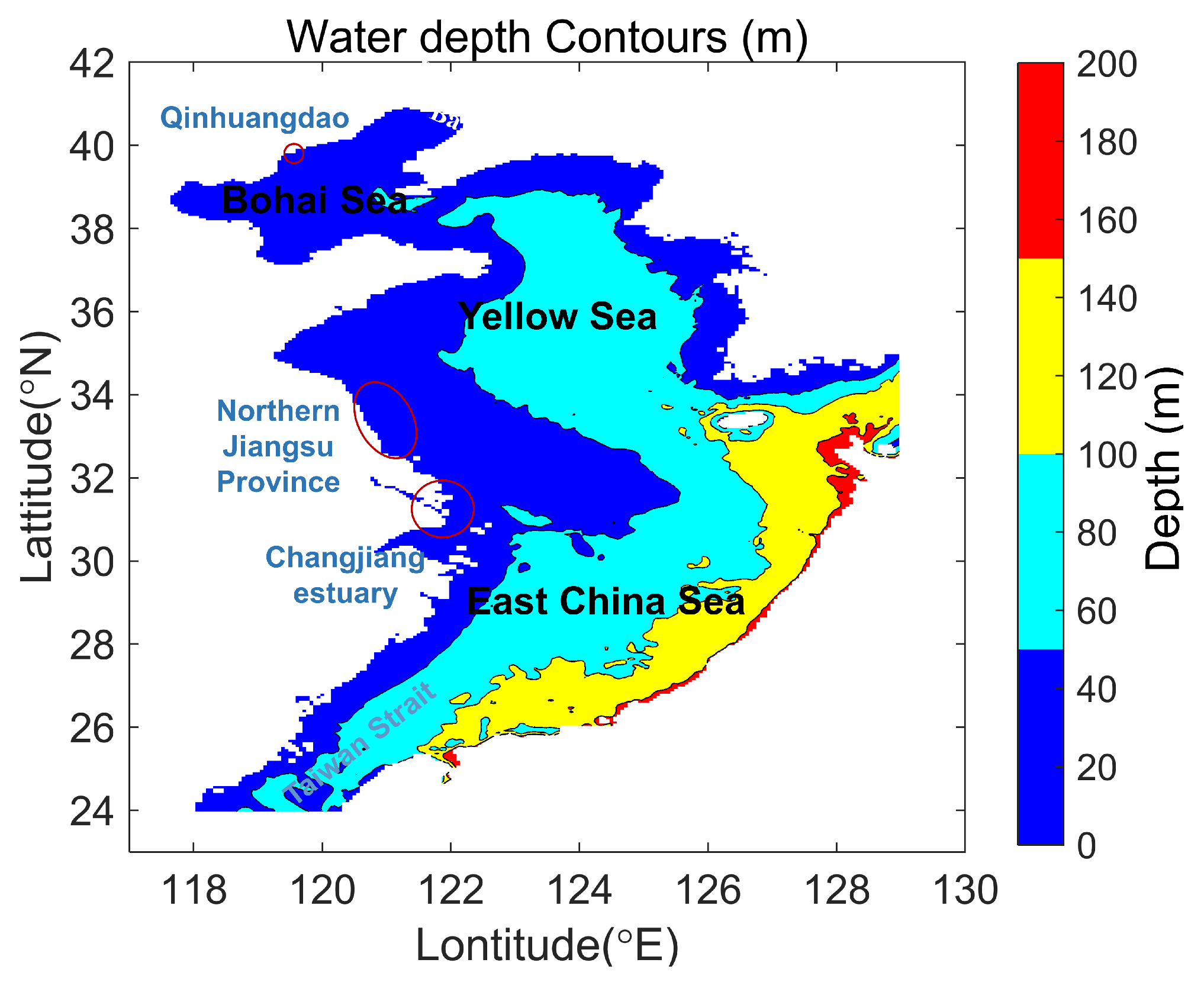
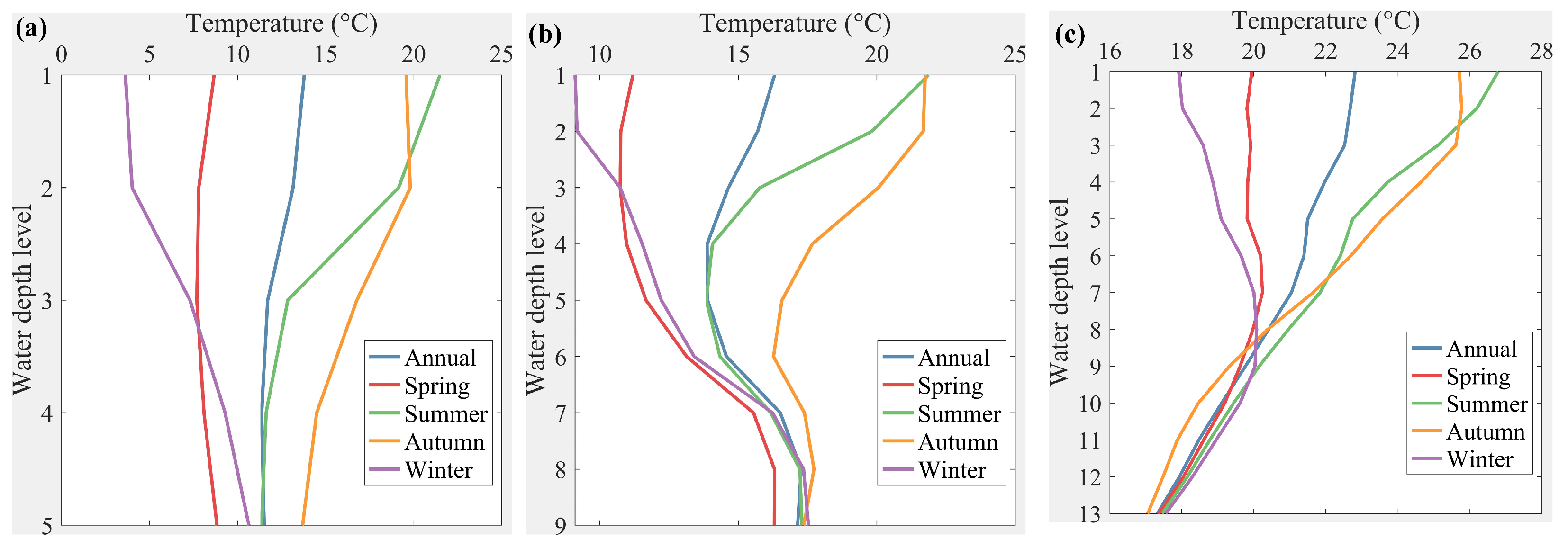

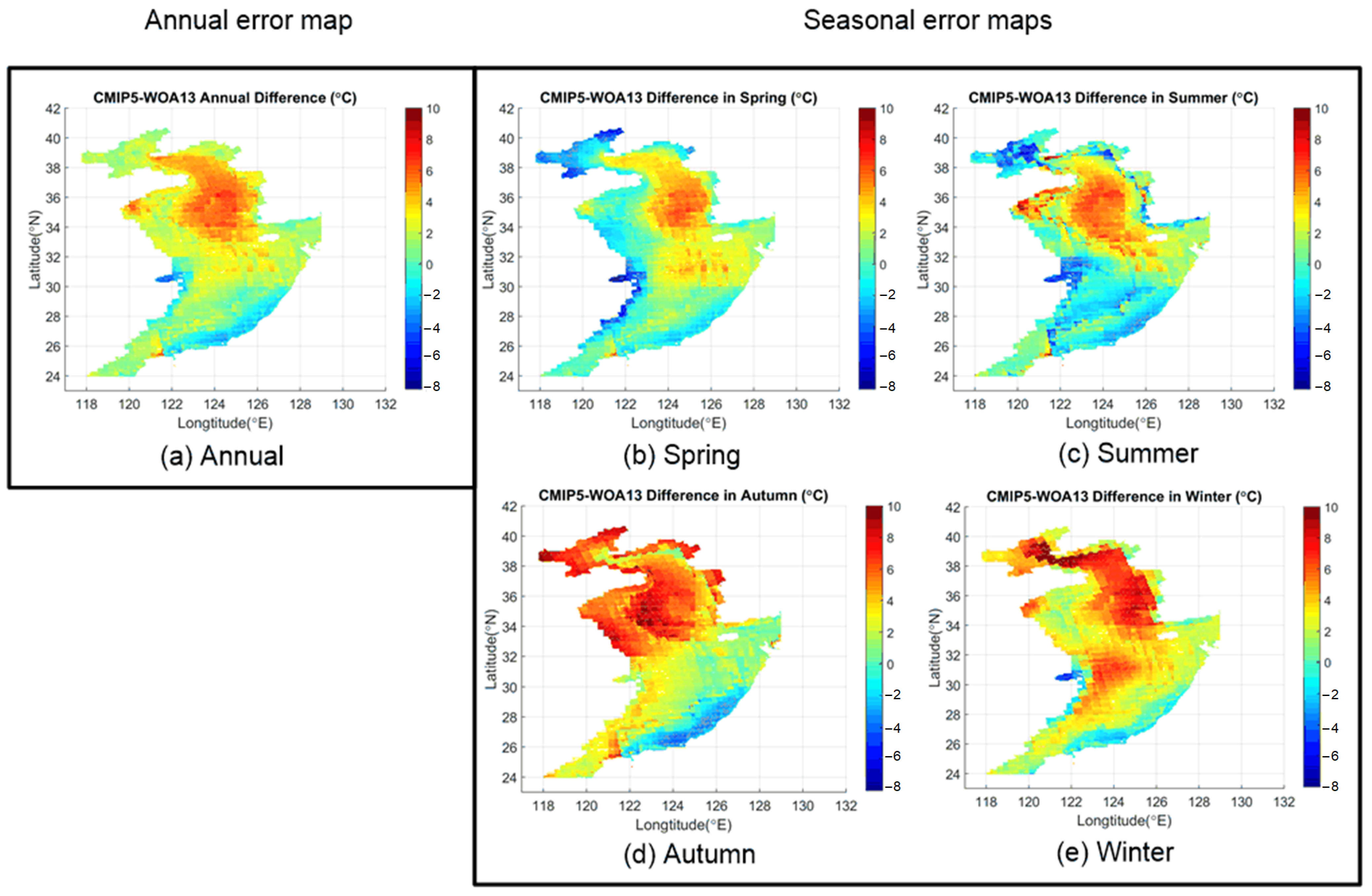
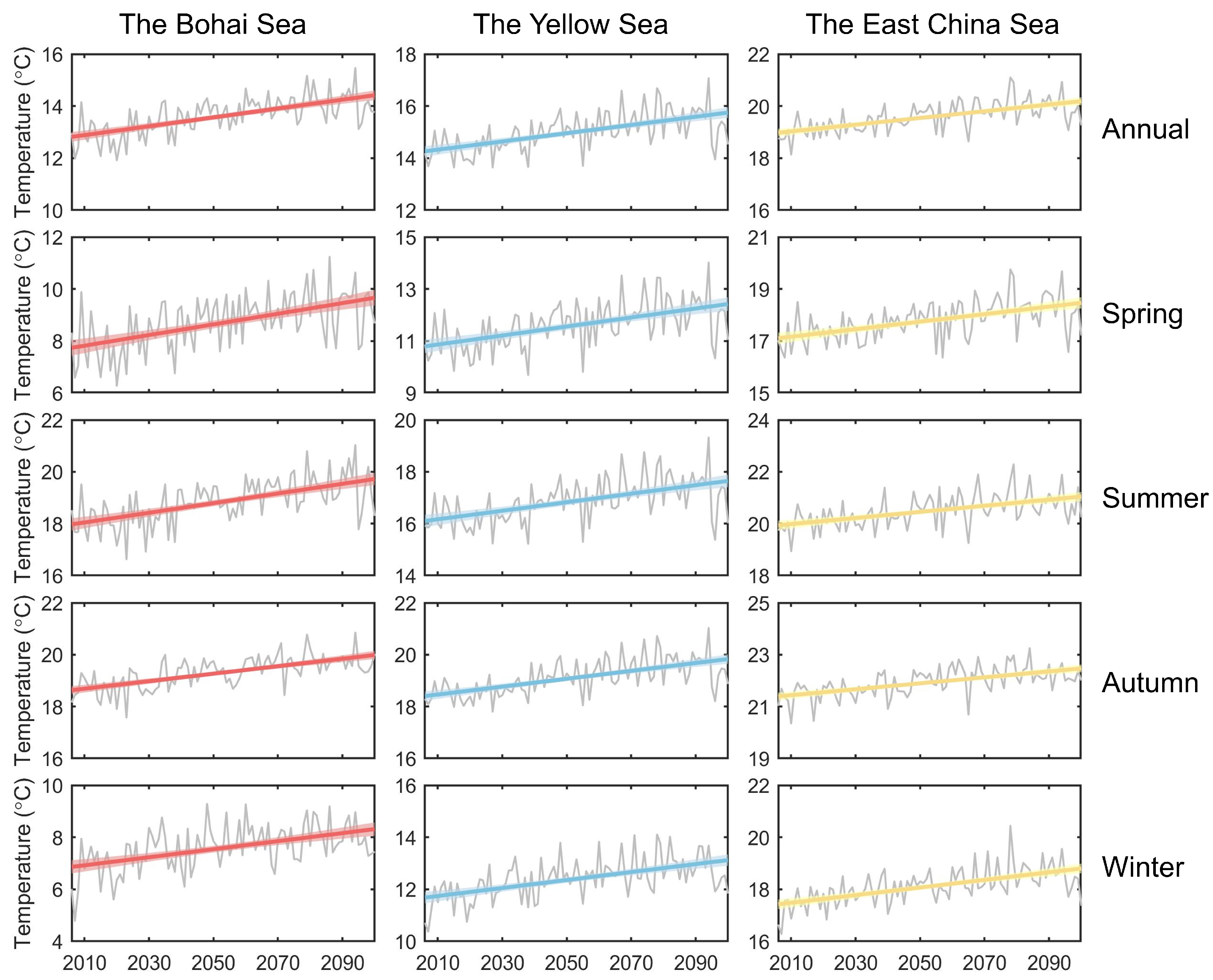
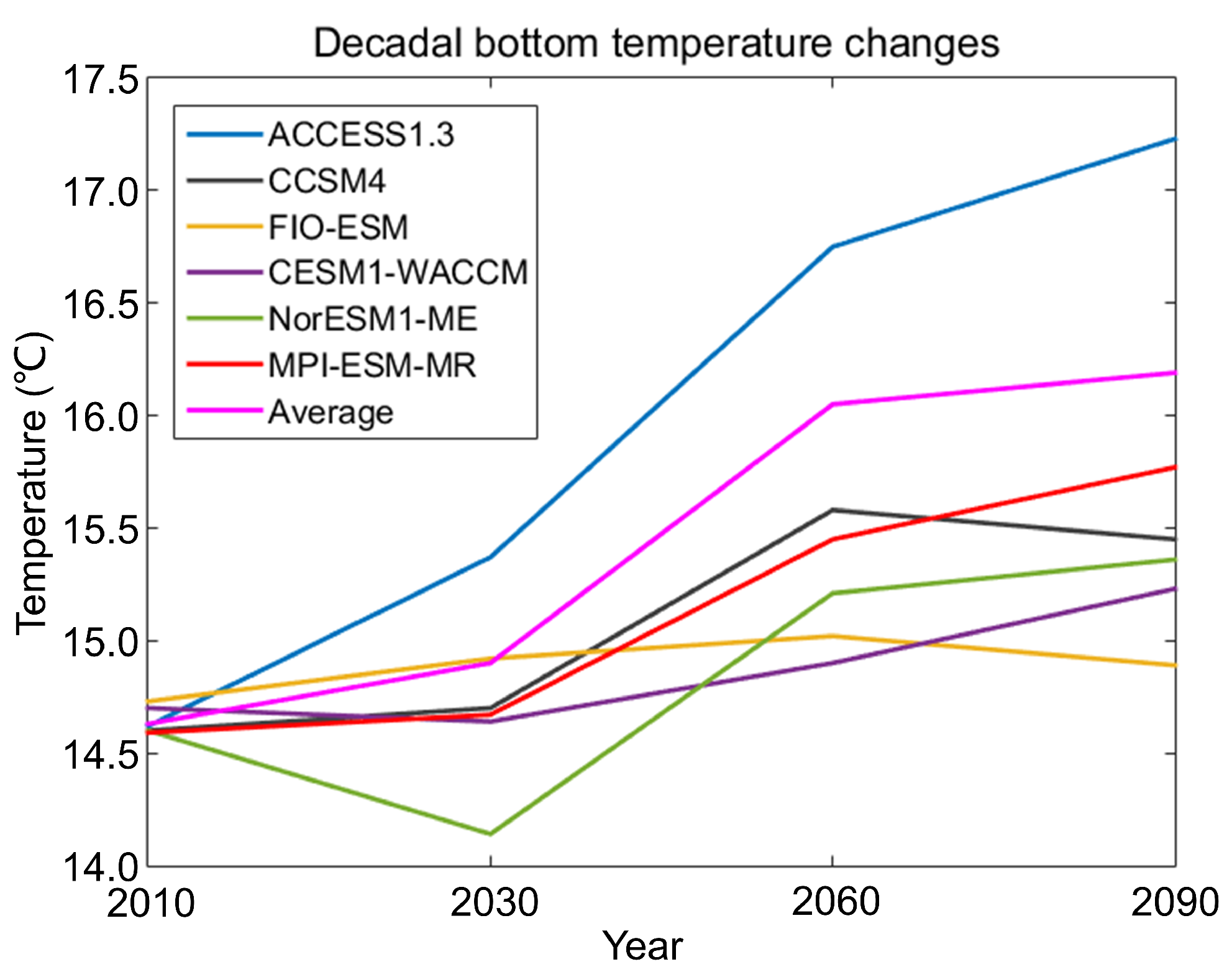
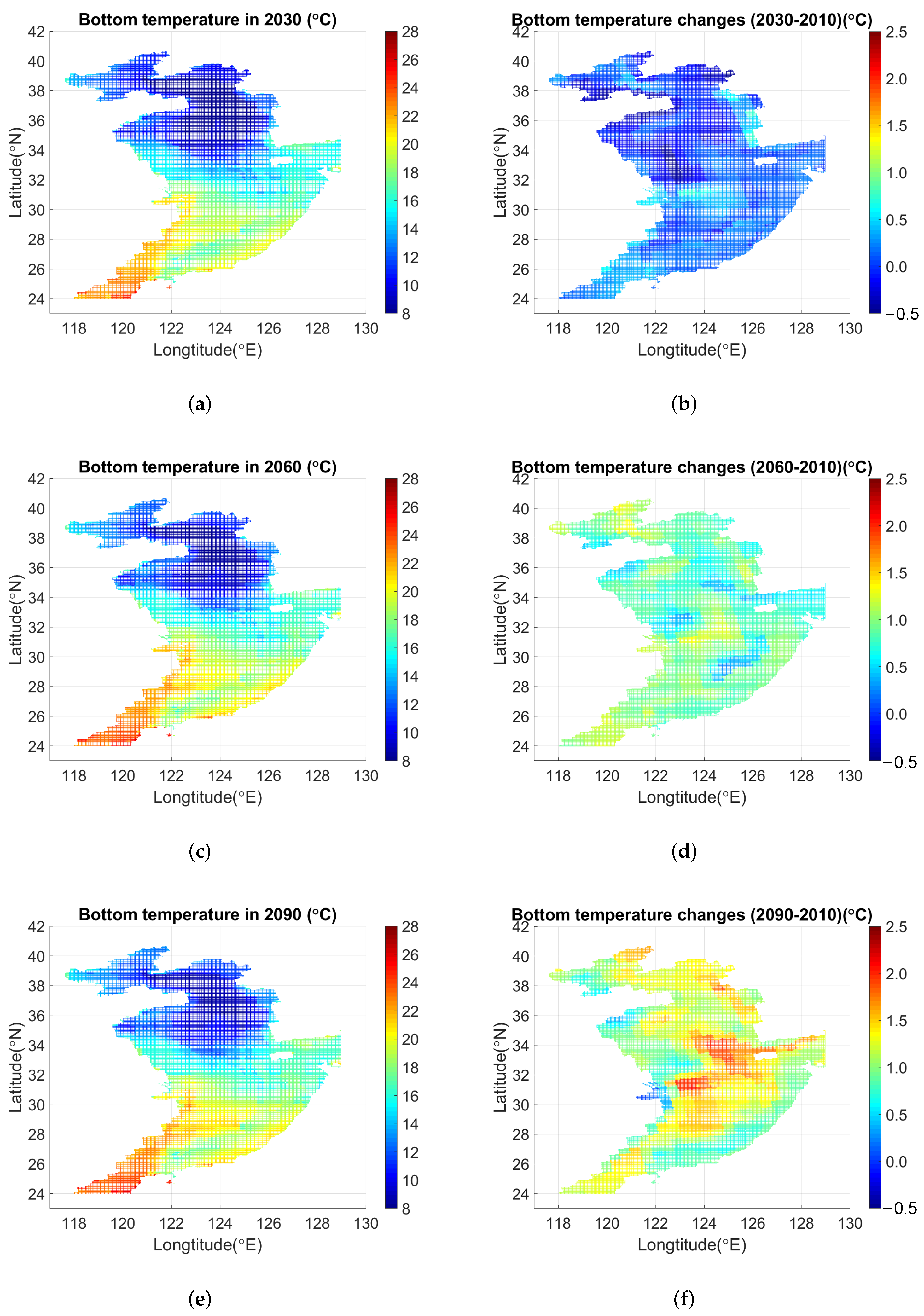
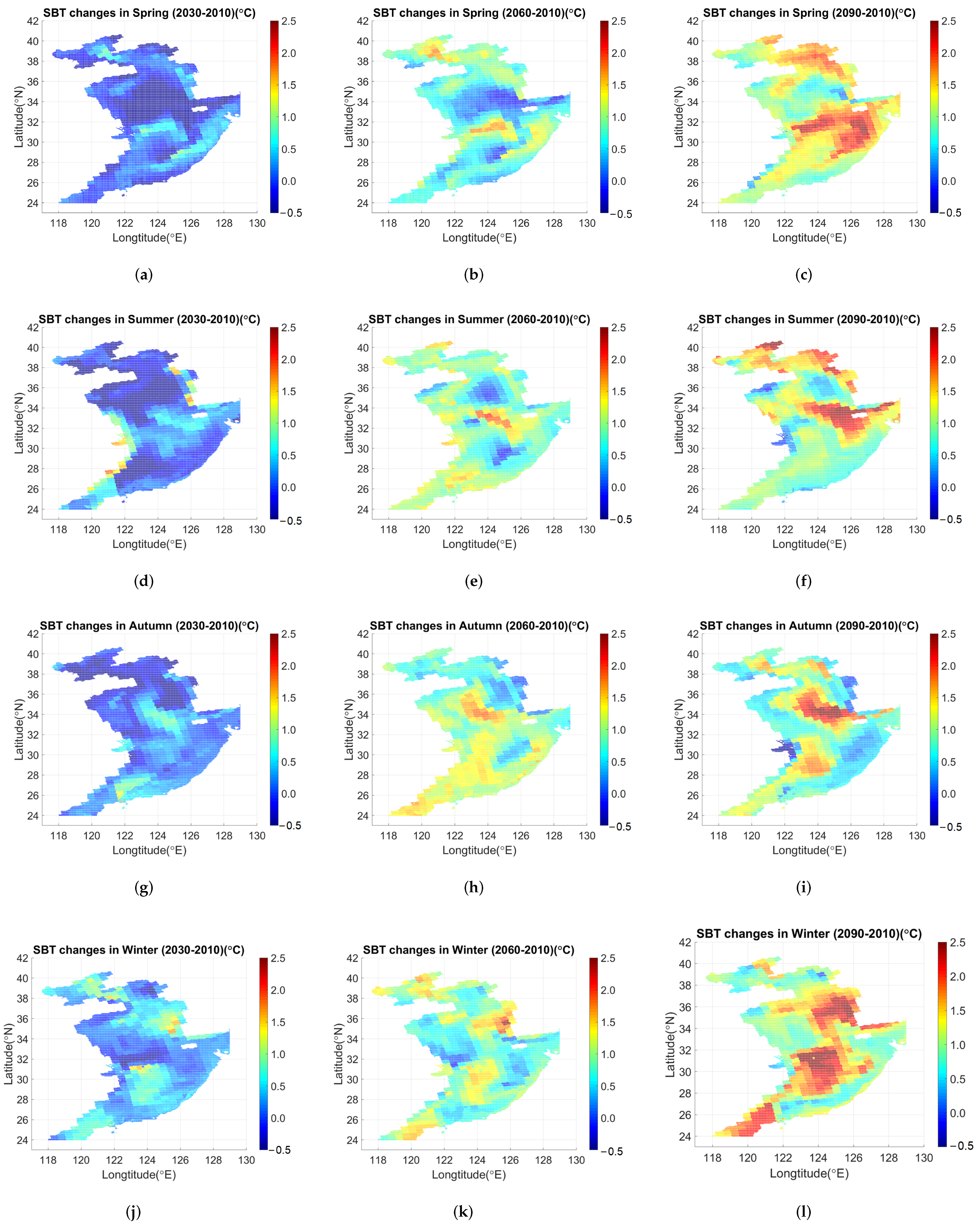
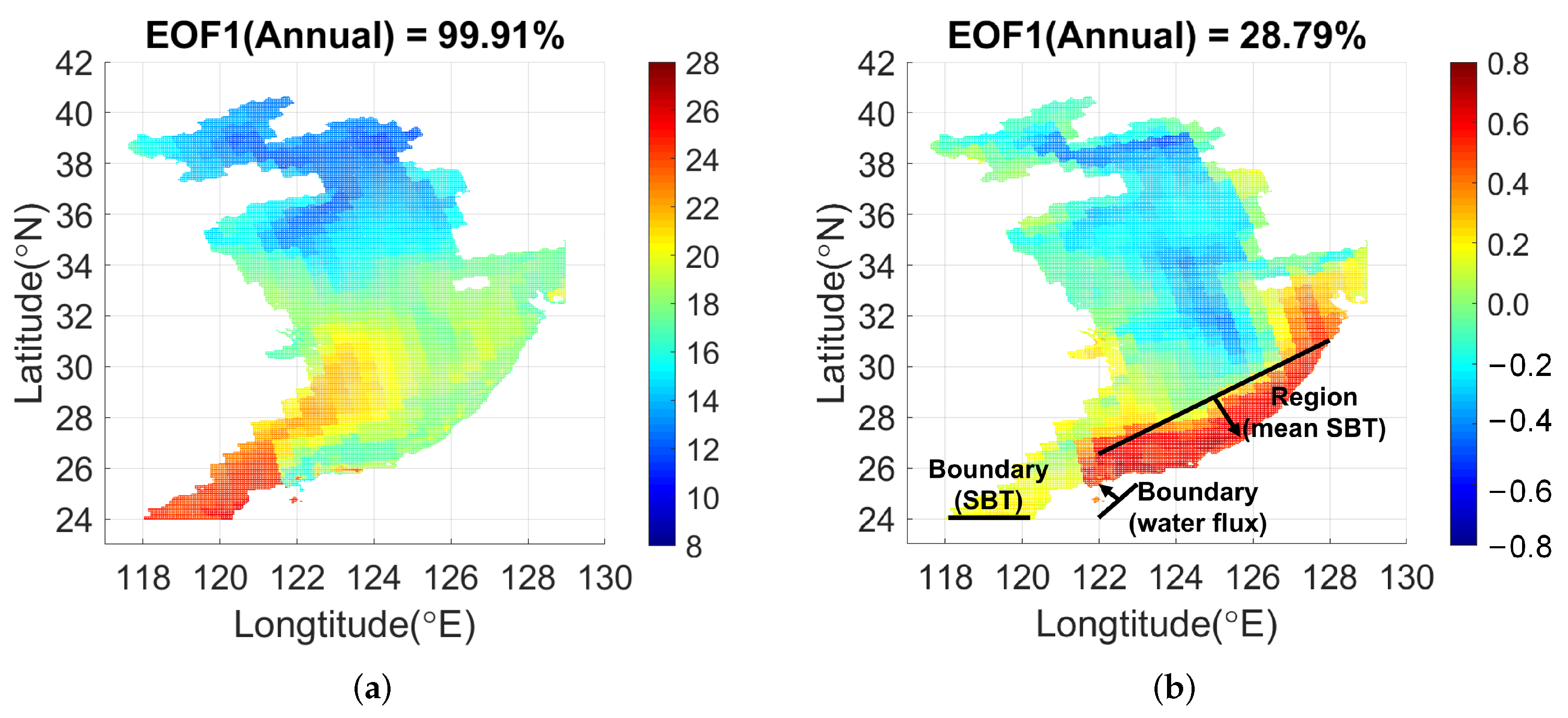
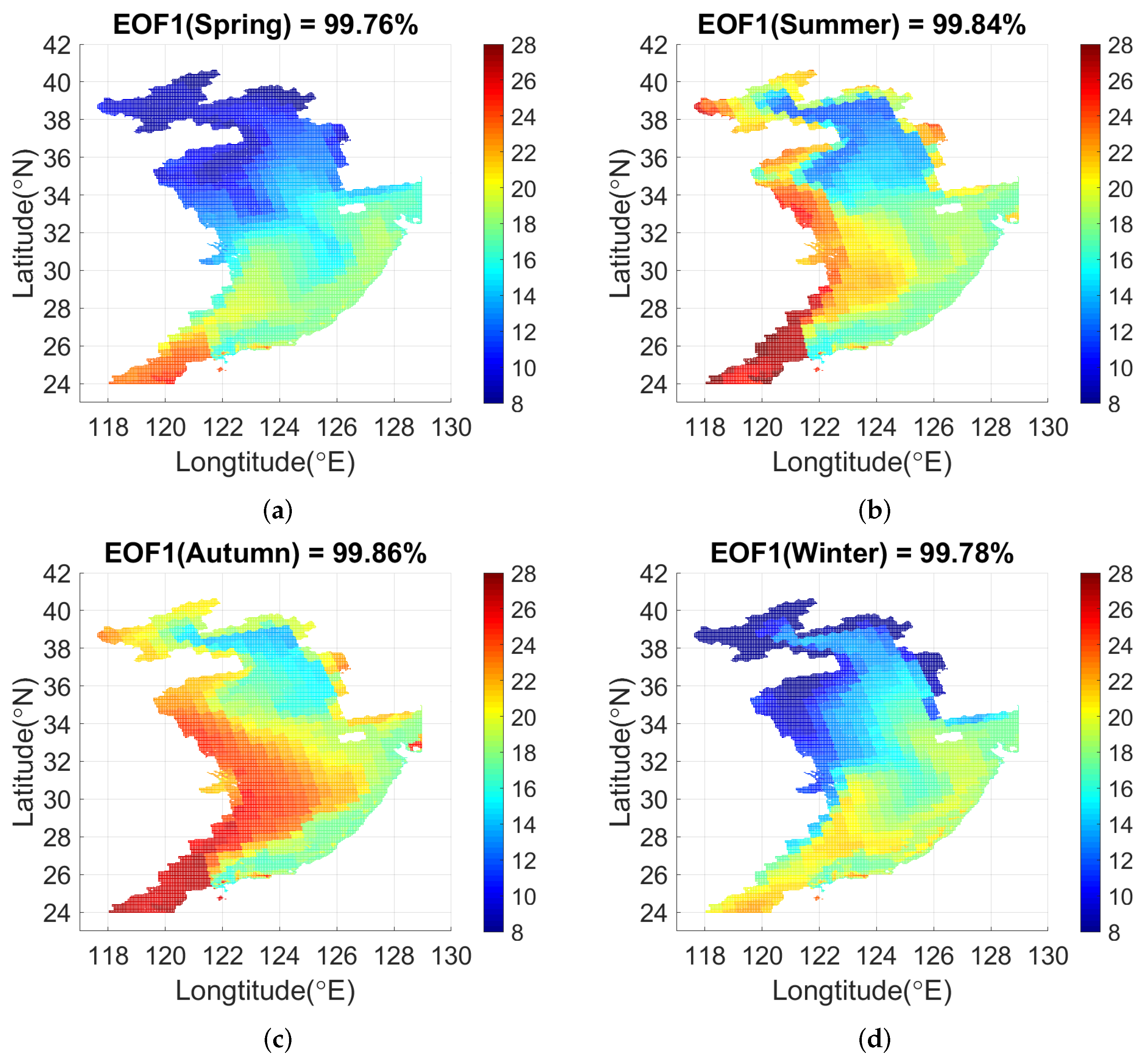
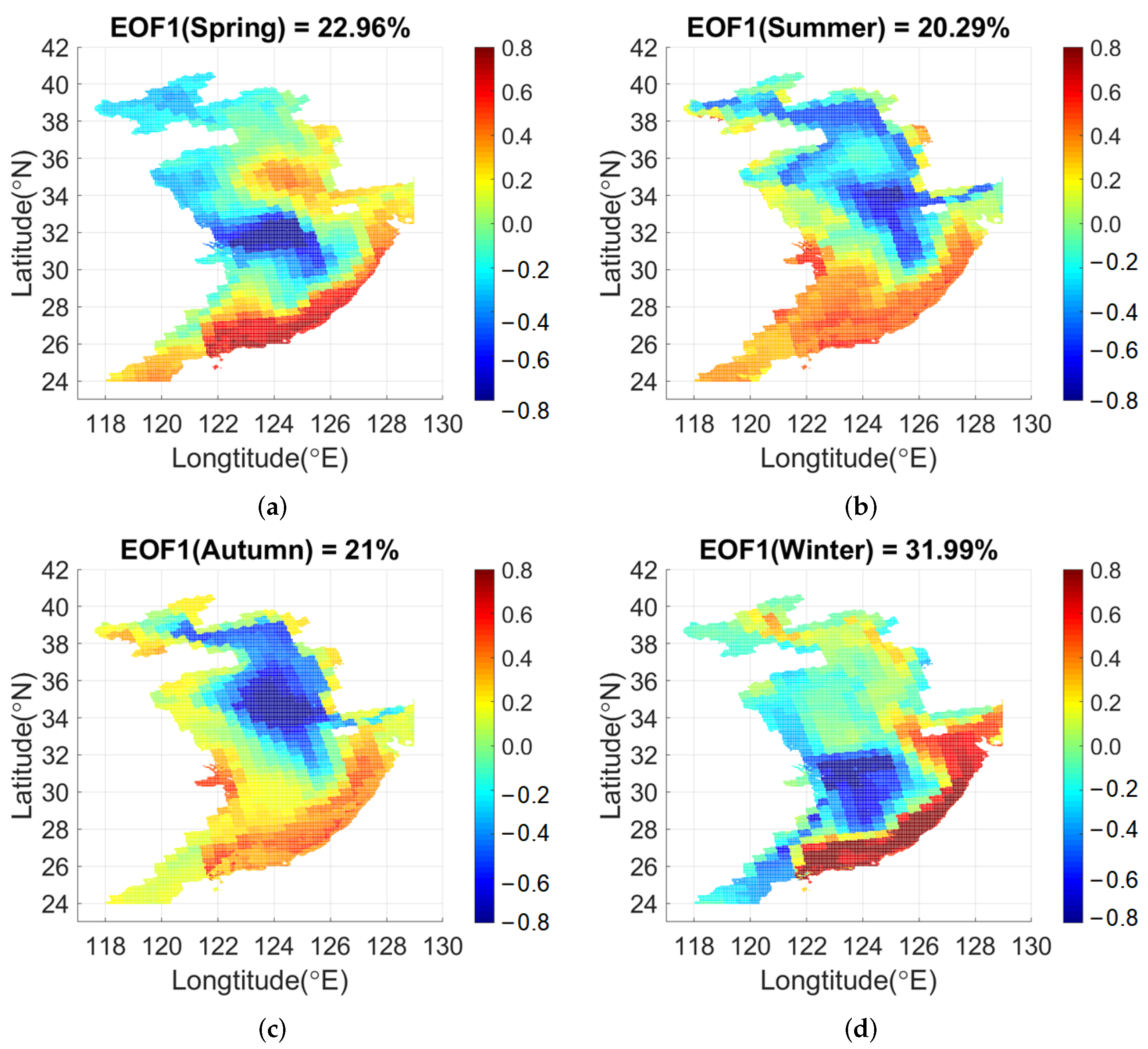
| Model Name | Vertical Grid | Horizontal Resolution | Reference |
|---|---|---|---|
| ACCESS1.3 | z 50 | 0.3° × 1.0° | [35] |
| CCSM4 | z 60 | 0.5° × 1.1° | [36] |
| FIO-ESM | z 40 | 0.5° × 1.1° | [37] |
| CESM1-WACCM | z 60 | 0.5° × 1.1° | [38] |
| NorESM1-ME | z 70 | 0.5° × 1.1° | [39] |
| MPI-ESM-MR | z 40 | 0.1° × 0.1° | [40] |
| Data Source | Yearly-Mean | Spring | Summer | Autumn | Winter | |
|---|---|---|---|---|---|---|
| WOA18 | 14.76 | 13.47 | 17.87 | 16.63 | 16.40 | |
| CMIP5 Model Errors | ACCESS1.3 | 0.69 | 0.65 | 1.40 | 1.30 | 0.83 |
| CCSM4 | 0.74 | 0.83 | 1.30 | 1.26 | 0.91 | |
| FIO-ESM | 1.16 | 0.67 | 0.95 | 1.71 | 1.32 | |
| CESM1-WACCM | 1.21 | 0.96 | 0.37 | 1.37 | 2.14 | |
| NorESM1-ME | 0.87 | 0.84 | 1.15 | 1.30 | 1.16 | |
| MPI-ESM-MR | 0.77 | 0.33 | 0.30 | 1.22 | 1.21 | |
| SBT Changes (2100–2006) | Ann. | Spr. | Sum. | Aut. | Win. |
|---|---|---|---|---|---|
| Bohai Sea | 1.60 | 1.92 | 1.75 | 1.36 | 1.45 |
| Yellow Sea | 1.49 | 1.63 | 1.55 | 1.43 | 1.44 |
| East China Sea | 1.21 | 1.36 | 1.11 | 1.08 | 1.38 |
| SBT | 2010s | 2030s | 2060s | 2090s |
|---|---|---|---|---|
| ACCESS1.3 | 14.62 | 15.37 | 16.75 | 17.23 |
| CCSM4 | 14.60 | 14.70 | 15.58 | 15.45 |
| FIO-ESM | 14.73 | 14.92 | 15.02 | 14.89 |
| CESM1-WACCM | 14.70 | 14.64 | 14.90 | 15.23 |
| NorESM1-ME | 14.60 | 14.14 | 15.21 | 15.36 |
| MPI-ESM-MR | 14.59 | 14.67 | 15.45 | 15.77 |
| Average | 14.63 | 14.90 | 16.05 | 16.19 |
| SBT changes | 2010 | 2030–2010 | 2060–2010 | 2090–2010 |
| change rate | (2030–2010)/years | (2060–2030)/years | (2090–2060)/years | |
| ACCESS1.3 | 14.62 | 0.75 | 2.13 | 2.61 |
| 0.036 | 0.045 | 0.015 | ||
| CCSM4 | 14.60 | 0.10 | 0.98 | 0.85 |
| 0.005 | 0.028 | −0.004 | ||
| FIO-ESM | 14.73 | 0.18 | 0.29 | 0.15 |
| 0.009 | 0.003 | −0.004 | ||
| CESM1-WACCM | 14.70 | −0.06 | 0.20 | 0.53 |
| −0.003 | 0.009 | 0.011 | ||
| NorESM1-ME | 14.60 | −0.46 | 0.60 | 0.76 |
| −0.022 | 0.034 | 0.005 | ||
| MPI-ESM-MR | 14.59 | 0.09 | 0.86 | 1.18 |
| 0.004 | 0.025 | 0.010 | ||
| Average | 14.63 | 0.27 | 1.43 | 1.56 |
| 0.013 | 0.037 | 0.004 |
| SBT | 2010s | 2030s | 2060s | 2090s | ||||||||||||
|---|---|---|---|---|---|---|---|---|---|---|---|---|---|---|---|---|
| Spr. | Sum. | Aut. | Win. | Spr. | Sum. | Aut. | Win. | Spr. | Sum. | Aut. | Win. | Spr. | Sum. | Aut. | Win. | |
| ACCESS1.3 | 13.25 | 17.38 | 16.58 | 11.27 | 13.82 | 17.97 | 17.53 | 12.17 | 15.28 | 19.79 | 19.00 | 12.95 | 15.66 | 20.19 | 19.50 | 13.56 |
| CCSM4 | 13.20 | 17.40 | 16.62 | 11.18 | 13.20 | 17.53 | 16.83 | 11.25 | 14.23 | 18.35 | 17.54 | 12.21 | 13.95 | 18.36 | 17.71 | 11.79 |
| FIO-ESM | 13.36 | 17.49 | 16.71 | 11.36 | 13.60 | 17.68 | 16.67 | 11.71 | 13.61 | 17.81 | 16.99 | 11.67 | 13.46 | 17.77 | 16.92 | 11.38 |
| CESM1-WACCM | 13.32 | 17.46 | 16.69 | 11.33 | 13.29 | 17.40 | 16.68 | 11.19 | 13.43 | 17.72 | 17.09 | 11.37 | 13.73 | 18.06 | 17.35 | 11.78 |
| NorESM1-ME | 13.22 | 17.41 | 16.61 | 11.17 | 12.71 | 17.05 | 16.39 | 10.43 | 13.87 | 18.19 | 17.47 | 11.29 | 13.93 | 18.44 | 17.62 | 11.46 |
| MPI-ESM-MR | 13.26 | 17.45 | 16.53 | 11.11 | 13.20 | 17.45 | 16.59 | 11.46 | 13.96 | 18.35 | 17.50 | 11.99 | 14.56 | 18.61 | 17.48 | 12.44 |
| Average | 13.22 | 17.63 | 16.63 | 11.02 | 13.40 | 17.89 | 16.96 | 11.34 | 14.64 | 19.19 | 18.16 | 12.23 | 14.70 | 19.35 | 18.36 | 12.34 |
| SBT Changes | 2010s | 2030s–2010s | 2060s–2010s | 2090s–2010s | ||||||||||||
| Spr. | Sum. | Aut. | Win. | Spr. | Sum. | Aut. | Win. | Spr. | Sum. | Aut. | Win. | Spr. | Sum. | Aut. | Win. | |
| ACCESS1.3 | 13.25 | 17.38 | 16.58 | 11.27 | 0.57 | 0.58 | 0.95 | 0.90 | 2.02 | 2.41 | 2.41 | 1.69 | 2.40 | 2.81 | 2.92 | 2.30 |
| CCSM4 | 13.20 | 17.40 | 16.62 | 11.18 | 0.01 | 0.12 | 0.21 | 0.06 | 1.03 | 0.95 | 0.92 | 1.03 | 0.75 | 0.96 | 1.09 | 0.60 |
| FIO-ESM | 13.36 | 17.49 | 16.71 | 11.36 | 0.24 | 0.19 | −0.04 | 0.35 | 0.24 | 0.31 | 0.28 | 0.31 | 0.10 | 0.28 | 0.02 | 0.02 |
| CESM1-WACCM | 13.32 | 17.46 | 16.69 | 11.33 | −0.03 | −0.06 | −0.01 | −0.14 | 0.10 | 0.26 | 0.40 | 0.05 | 0.41 | 0.60 | 0.66 | 0.45 |
| NorESM1-ME | 13.22 | 17.41 | 16.61 | 11.17 | −0.51 | −0.36 | −0.21 | −0.75 | 0.65 | −0.78 | 0.86 | 0.11 | 0.74 | 1.03 | 1.01 | 0.29 |
| MPI-ESM-MR | 13.26 | 17.45 | 16.53 | 11.11 | −0.06 | 0.00 | 0.06 | 0.35 | 0.70 | 0.89 | 0.97 | 0.88 | 1.30 | 1.15 | 0.95 | 1.33 |
| Average | 13.22 | 17.63 | 16.63 | 11.02 | 0.18 | 0.25 | 0.33 | 0.32 | 1.42 | 1.56 | 1.52 | 1.21 | 1.48 | 1.72 | 1.73 | 1.32 |
| Impact Factor | Annual | Spring | Summer | Autumn | Winter |
|---|---|---|---|---|---|
| Taiwan Warm Current SBT | 0.57 | 0.58 | 0.49 | 0.38 | 0.07 |
| Kuroshio water flux | −0.41 | −0.39 | −0.63 | −0.56 | −0.42 |
| Critical Ocean Current | Annual | Spring | Summer | Autumn | Winter |
|---|---|---|---|---|---|
| Taiwan Warm Current Average SBT | 24.62 | 23.86 | 26.76 | 26.49 | 21.37 |
| Kuroshio Average SBT | 18.07 | 17.91 | 17.68 | 17.77 | 18.91 |
Disclaimer/Publisher’s Note: The statements, opinions and data contained in all publications are solely those of the individual author(s) and contributor(s) and not of MDPI and/or the editor(s). MDPI and/or the editor(s) disclaim responsibility for any injury to people or property resulting from any ideas, methods, instructions or products referred to in the content. |
© 2023 by the authors. Licensee MDPI, Basel, Switzerland. This article is an open access article distributed under the terms and conditions of the Creative Commons Attribution (CC BY) license (https://creativecommons.org/licenses/by/4.0/).
Share and Cite
Qiao, S.; Zhang, C.; Wei, H.; Lan, Y. Projected Sea Bottom Temperature Variability in the East China Shelf Seas by 2100. J. Mar. Sci. Eng. 2023, 11, 1192. https://doi.org/10.3390/jmse11061192
Qiao S, Zhang C, Wei H, Lan Y. Projected Sea Bottom Temperature Variability in the East China Shelf Seas by 2100. Journal of Marine Science and Engineering. 2023; 11(6):1192. https://doi.org/10.3390/jmse11061192
Chicago/Turabian StyleQiao, Shen, Cuicui Zhang, Hao Wei, and Yifan Lan. 2023. "Projected Sea Bottom Temperature Variability in the East China Shelf Seas by 2100" Journal of Marine Science and Engineering 11, no. 6: 1192. https://doi.org/10.3390/jmse11061192
APA StyleQiao, S., Zhang, C., Wei, H., & Lan, Y. (2023). Projected Sea Bottom Temperature Variability in the East China Shelf Seas by 2100. Journal of Marine Science and Engineering, 11(6), 1192. https://doi.org/10.3390/jmse11061192







